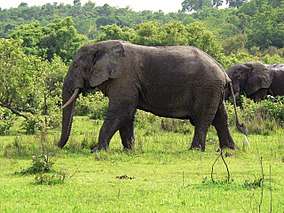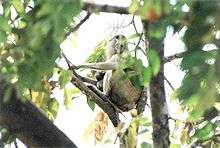Mole National Park
,Mole National Park is Ghana's largest wildlife refuge.[1] The park is located in the Savannah region of Ghana on savanna and riparian ecosystems at an elevation of 150 m, with a sharp escarpment forming the southern boundary of the park. The park's entrance is reached through the nearby town of Larabanga.[1] The Lovi and Mole Rivers are ephemeral rivers flowing through the park, leaving behind only drinking holes during the long dry season.[2] This area of Ghana receives over 1000 mm per year of rainfall. A long-term study has been done on Mole National Park to understand the impact of human hunters on the animals in the preserve.
| Mole National Park | |
|---|---|
 An African bush elephant at the park | |
 | |
| Location | Ghana |
| Nearest city | Larabanga |
| Coordinates | 9°42′N 1°50′W |
| Area | 4840 km2 |
| Established | 1958 |
History
The park's lands were set aside as a wildlife refuge in 1958. In 1971, the small human population of the area was relocated and the lands were designated a national park. The park has not seen major development as a tourist location since its original designation. The park as a protective area is underfunded and national and international concerns exist about poaching and sustainability in the park, but its protection of important resident antelope species has improved since its initial founding as a preserve.[4][5]
The park is an important study area for scientists because of the removal of the human population from within the park allowing for some long-term studies, in particular, of relatively undisturbed sites compared to similar areas of densely populated equatorial West Africa. One study on the resident population of 800 elephants, for example, indicates that elephant damage to large trees varies with species. In Mole, elephants have a greater tendency to seriously injure economically important species such as Burkea africana, an important tropical hardwood, and Butyrospermum paradoxum, the source of shea butter, over the less important Terminalia spp.[6]
Recently, honey made from flowers in the Molé National Forest has become the region's first fair-trade commodity.[7] Nearby, villagers harvest the honey using traditional, non-invasive methods, and have partnered with a Utah-based company to sell the honey as a health and wellness supplement in the US.[8] The program was co-founded by Ashanti Chief Nana Kwasi Agyemang, who hopes to re-ignite local interest in the honey and eventually export it to other countries in Africa.[9]
Flora

Tree species of the park include Burkea africana, Isoberlinia doka, and Terminalia macroptera. The savanna grasses are somewhat low in diversity but known species include a spikesedge, Kyllinga echinata, an Aneilema, Aneilema setiferum var. pallidiciliatum, and two endemic members of the Asclepiadaceae subfamily, the vine Gongronema obscurum, and the edible geophyte, Raphionacme vignei.[6][10][11][12]
Trees:
- Adansonia digitata
- Afzelia africana
- Anogeissus leiocarpus
- Afraegle paniculata
- Burkea africana
- Butyrospermum paradoxum
- Cassia sieberana
- Celastrus senegalensis
- Combretum ghasalense
- Detarium microcarpum
- Grewia lasiodiscus
- Grewia mollis
- Lannea acida
- Maytenus senegalensis
- Piliostigma thonningii
- Pterocarpus erinaceus
- Sterculia setigera
- Tamarindus indica
- Terminalia spp., including T. avicennioides
- Ximenia americana
Shrubs:
- Diospyros mespiliformis
- Feretia apodanthera
- Flueggea virosa
- Tinnsea spp.
- Urginea spp.
Herbaceous plants:
- Abutilon ramosum
- Aneilema umbrosum
- Atylosia scarabaeoides
- Blepharis maderaspatensis
- Desmodium velutinum
- Mariscus alternifolius
- Ruellia
- Sida urens
- Triumfetta pentandra
- Wissadula amplissima
Grasslands:
- Andropogon spp., including Andropogon gayanus var. squamulatus (a tall grass)
- Brachiaria spp.
- Loudetiopsis kerstingii
- Sporobolus pyramidalis (only in protected areas)
- Setaria barbata (only in protected areas)
Fauna

The park is home to over 93 mammal species, and the large mammals of the park include an elephant population, hippos, buffalo, and warthogs.[13][14] The park is considered a primary African preserve for antelope species including kob, defassa waterbuck, roan, hartebeest, oribi, the bushbuck, and two duikers, the red duiker and yellow-backed duiker.[4][13][14][15][16] Olive baboons, black-and-white colobus monkeys, the green vervet, and patas monkeys are the known species of monkeys resident in the park.[13] Of the 33 known species of reptiles slender-snouted and dwarf crocodile are found in the park.[1][13][14] Sightings of hyenas, lions and leopards are unusual, but these carnivores were once more common in the park.[14] Among the 344 listed bird species are the martial eagle, the white-headed and palm-nut vultures, saddle-billed storks, herons, egrets, the Abyssinian roller, the violet turaco, various shrikes and the red-throated bee-eater.[1]
Mole National Park, like other Ghanaian game preserves, is poorly funded for prevention of poaching. Nevertheless, the fauna of the park is guarded by professional rangers,[17] and the poachers are at real risk to be put under arrest. Poachers tend to live within 50 km of the boundaries of the park. This distance of 50 km is the reported greatest distance hunters were willing to travel with poached game. The remnant human population of the park was removed in 1961, leaving all game hunters outside the reserve, meaning that mammal populations on the edges of the park are impacted more by hunting than interior populations.
Tourism
After improvements to the roads leading to the park , the number of visitors to the park increased from 14,600 in 2014 to 17,800 in 2015. Depending on the year, 20%-40% of visitors are foreign. Mr. Farouk Umaru Dubiure, the Park Manager, says “Though we received many visitors, the funds generated were very low because 70 percent of the visitors were Ghanaian students who pay little to visit the park. These students also visit the Park on the same day and return, compared to the foreigners who spend more days to view the Park well” [18]
See also
- Wildlife of Ghana
- West Africa
References
- Briggs, Philip J. (2007). Ghana, 4th (Bradt Travel Guide). Bradt Travel Guides. ISBN 1-84162-205-2.
- Bowell, R. T.; R. K. Ansah (1993). "Trace Element Budget in an African Savannah Ecosystem". Biogeochemistry. 20 (2): 103–126. doi:10.1007/BF00004137.
- East, R. (Rod); IUCN/SSC Antelope Specialist Group. (1999). African Antelope Database 1999. Gland, Switzerland: IUCN Species Survival Commission. ISBN 2-8317-0477-4.
- Stuart, S. N.; Adams, Richard J.; Jenkins, Martin (1990). Biodiversity in Sub-Saharan Africa and its Islands : Conservation, Management, and Sustainable Use (Occasional Papers of "Hte Iucn" Species Survival Com). Gland, Switzerland: IUCN. ISBN 2-8317-0021-3.
- Sackey, I; WHG Hale (2008). "The Impact of Elephants on the Woody Vegetation of Mole National Park, Ghana". Journal of the Ghana Science Association. 10 (2): 28–38. doi:10.4314/jgsa.v10i2.18038.
- "Who We Are - Aseda Raw Honey". Aseda Raw Honey. Retrieved 2016-02-29.
- McCord, Keith. "Utah company's honey business changes lives in Africa". DeseretNews.com. Retrieved 2016-02-29.
- "Made In Ghana, Sold In U.S.A: Honey Co-Op Provides Jobs In Africa". AFKInsider. Retrieved 2016-02-29.
- "Mole National Park - UNESCO World Heritage Centre".
- Sobey, Douglas G. (1978). "Anogeissus Groves on Abandoned Village Sites in the Mole National Park, Ghana". Biotropica. 10 (2): 87–99. doi:10.2307/2388011. JSTOR 2388011.
- Benzie, John A. H. (1986). "The Distribution, Abundance, and the Effects of Fire on Mound Building Termites (Trinervitermes and Cubitermes spp., Isoptera: Termitidae) in Northern Guinea Savanna West Africa". Oecologia. 70 (4): 559–567. doi:10.1007/BF00379904.
- Riley, William; Riley, Laura (2005). Nature's strongholds: the world's great wildlife reserves. Princeton, N.J: Princeton University Press. ISBN 0-691-12219-9.
- Pamela K. Brodowsky and the National Wildlife Federation (2009). Destination Wildlife : An International Site-By-Site Guide to the Best Places to Experience Endangered, Rare, and Fascinating Animals and Their Habitat. New York: Penguin. ISBN 978-0-399-53486-7.
- East, R. (Rod); Mallon, D. P. (David P.); Kingswood, Steven Charles (1989). Antelopes : global survey and regional action plan. Gland, Switzerland: International Union for Conservation of Nature and Natural Resources. ISBN 2-8317-0016-7.
compiled by R. East.
- Brashares, Justin S.; Moses K. Sam (2005). "How much is enough? Estimating the minimum sampling required for effective monitoring of African reserves". Biodiversity and Conservation. 14 (11): 2709–2722. doi:10.1007/s10531-005-8404-z.
- "Photographs of Mole National Park, April 2016". Independent Travellers. independent-travellers.com. Retrieved July 14, 2017.
- http://www.businessworldghana.com/mole-park-attracts-more-tourists/
External links
| Wikimedia Commons has media related to Mole National Park. |
| Wikivoyage has a travel guide for Mole National Park. |
www.grassroottoursghana.com